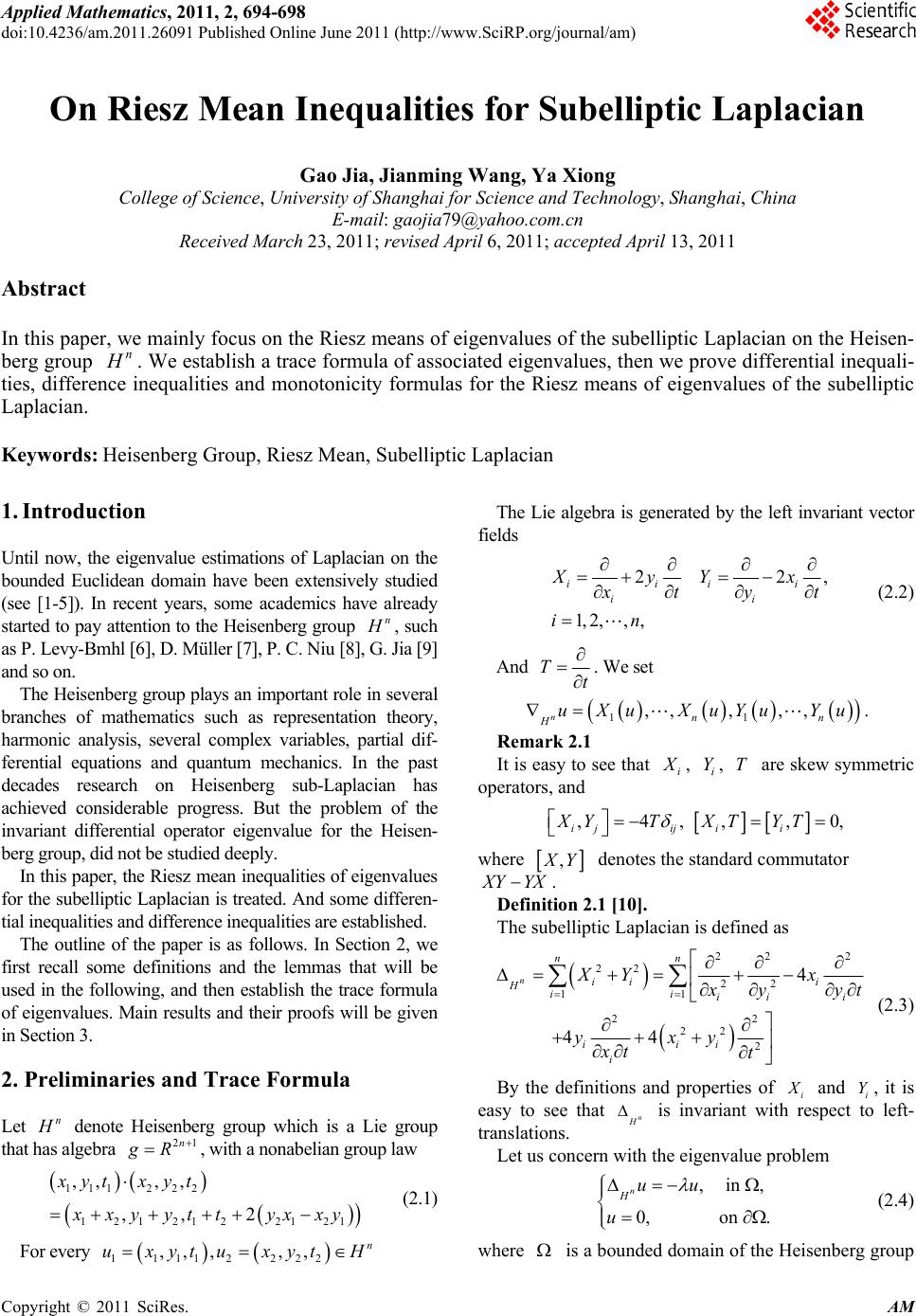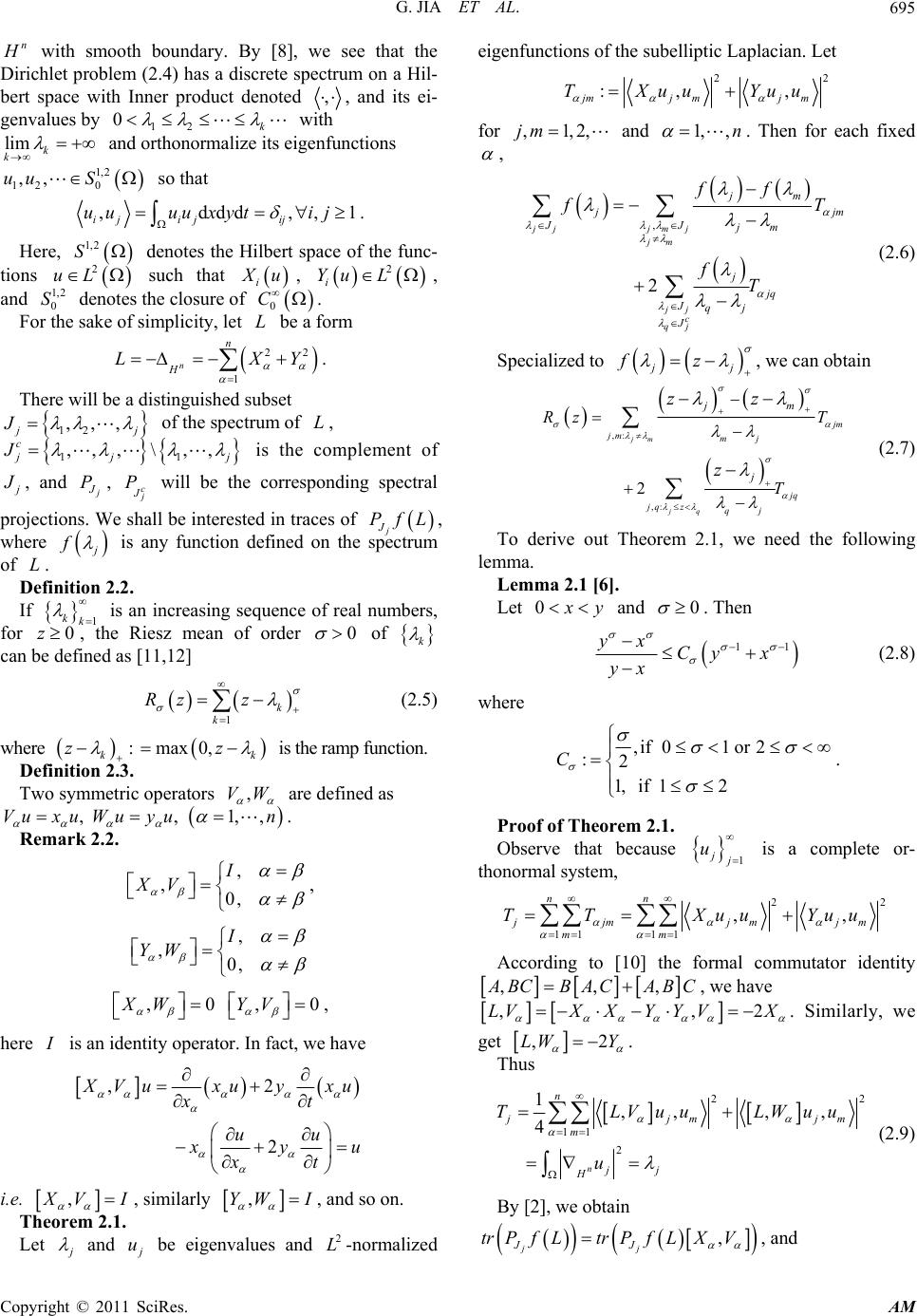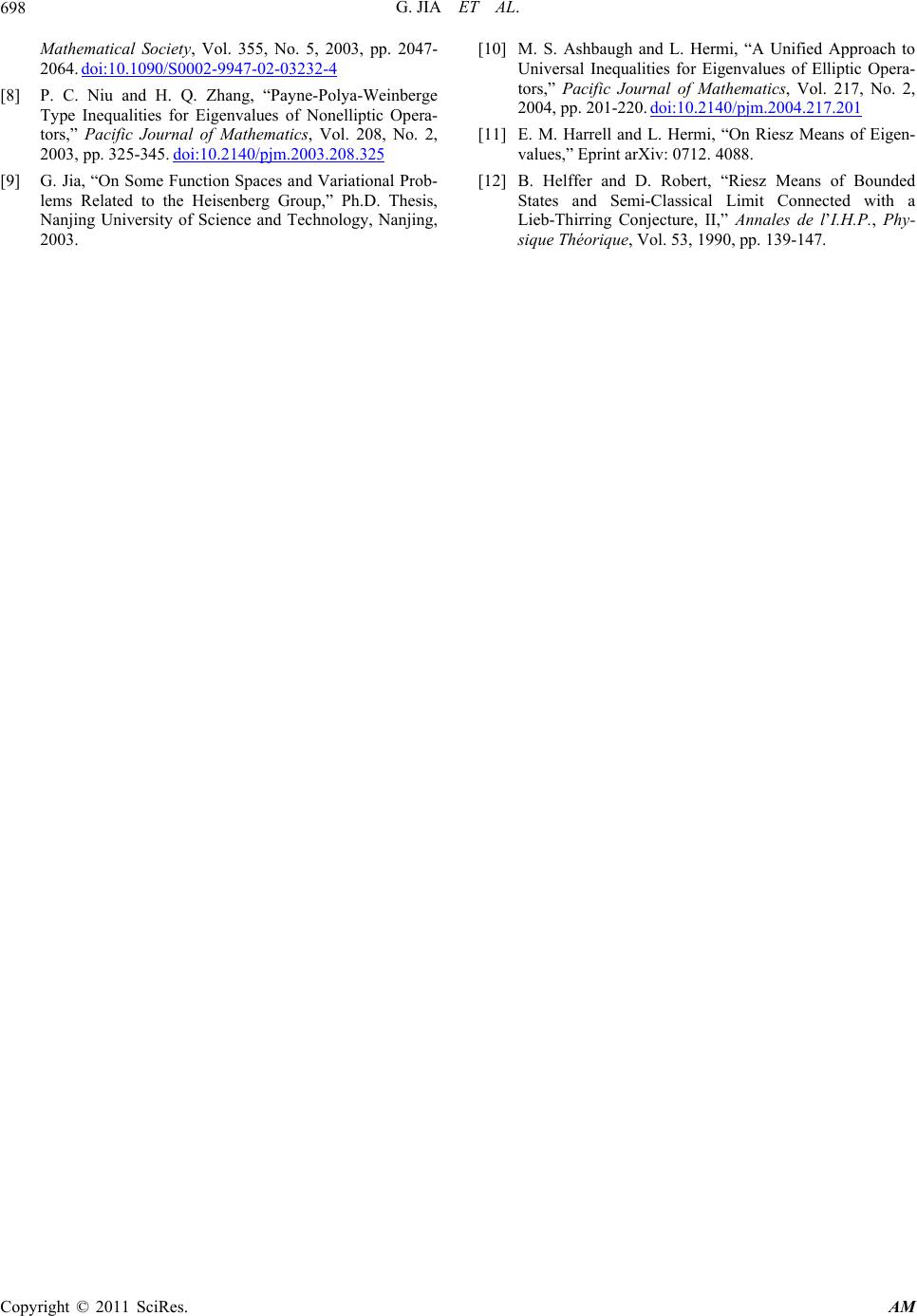 Applied Mathematics, 2011, 2, 694-698 doi:10.4236/am.2011.26091 Published Online June 2011 (http://www.SciRP.org/journal/am) Copyright © 2011 SciRes. AM On Riesz Mean Inequalities for Subelliptic Laplacian Gao Jia, Jianming Wang, Ya Xiong College of Science , U ni versi t y of Sh ang h ai fo r Scie nce an d Tech nology, Shanghai, China E-mail: gaojia79@yahoo.com.cn Received March 23, 20 1 1; revised April 6, 2011; accepted A p r il 13, 2011 Abstract In this paper, we mainly focus on the Riesz means of eigenvalues of the subelliptic Laplacian on the Heisen- berg group . We establish a trace formula of associated eigenvalues, then we prove differential inequali- ties, difference inequalities and monotonicity formulas for the Riesz means of eigenvalues of the subelliptic Laplacian. n H Keywords: Heisenberg Group, Riesz Mean, Subelliptic Laplacian 1. Introduction Until now, the eigenvalue estimations of Laplacian on the bounded Euclidean domain have been extensively studied (see [1-5]). In recent years, some academics have already started to pay attention to the Heisenberg group n , such as P. Levy-Bmhl [6], D. Müller [7], P. C. Niu [8], G. Jia [9] and so on. The Heisenberg group plays an important role in several branches of mathematics such as representation theory, harmonic analysis, several complex variables, partial dif- ferential equations and quantum mechanics. In the past decades research on Heisenberg sub-Laplacian has achieved considerable progress. But the problem of the invariant differential operator eigenvalue for the Heisen- berg group, did not be studied deeply. In this paper, the Riesz mean inequalities of eigenvalues for the subelliptic Laplacian is treated. And some differen- tial inequalities and difference inequaliti es are established. The outline of the paper is as follows. In Section 2, we first recall some definitions and the lemmas that will be used in the following, and then establish the trace formula of eigenvalues. Main results and their proofs will be given in Section 3. 2. Preliminaries and Trace Formula Let n denote Heisenberg group which is a Lie group that has algebra , with a nonabelian group law 21n gR 1112 22 121212 2121 ,, ,, ,, 2 xyt xyt xyyt tyxxy (2.1) For every 11112 222 ,, ,,,n uxytuxytH The Lie algebra is generated by the left invariant vector fields 2 2, 1, 2,,, iiii ii XyYx ty in t (2.2) And Tt . We set 11 ,,, ,, nnn HuXuXuYu Yu . Remark 2.1 It is easy to see that i , , are skew symmetr ic operators, and i YT ,4, ,, ijij ii XYTXT YT 0, where , Y denotes the standard commutator YYX . Definiti on 2.1 [10]. The subelliptic Laplacian is defined as 22 2 22 22 11 22 22 2 4 44 n nn ii i Hii i ii iii i XY x yt xy yxy xt t (2.3) By the definitions and properties of i and i Y, it is easy to see that n is invariant with respect to left- translations. Let us concern with the eigenvalue problem , in , 0, on . n Huu u (2.4) where is a bounded domain of the Heisenberg group  G. JIA ET AL.695 n with smooth boundary. By [8], we see that the Dirichlet problem (2.4) has a discrete spectrum on a Hil- bert space with Inner product denoted , , and its ei- genvalues by 12 0k with lim kk 12 uu 1, and orthonormalize its eigenfunctions 2 0,, S so that ,ddd ij ijij uuuu xyt ,,1ij. Here, denotes the Hilbert space of the func- tions such that 1,2 S 2 uL i u, 2 i Yu L , and denotes the closure of . 1,2 0 S C L0 For the sake of simplicity, let be a form 22 1 n n H LX Y . There will be a distinguish ed subset 12 ,,, j J ,,, c of the spectrum of , L 11 \ ,, jj J is the complement of , and P, c P will be the corresponding spectral projections. We shall be interested in traces of j J fL , where f is any function defined on the spectrum of . L Definition 2. 2. If is an increasing sequence of real numbers, for , the Riesz mean of order 1 kk 0z0 of k can be defined as [11 ,12] 1k k Rz z (2.5) where :max0, k z k z is the ram p function. Definition 2. 3. Two symmetric operators ,VW 1,,n are defined as . , ,xu Wuyu Vu Remark 2.2. , ,0, I XV , , ,0, I YW ,0 , XW YV 0 , here is an identity operator. In fact, we have ,2 2 Vuxu yxu xt uu yu xt i.e. , V I, similarly ,YW I , and so on. Theorem 2.1. Let and u be eigenvalues and -normalized eigenfunctions of the subelliptic Laplacian. Let 2 L 22 :, , jm jmjm TXuuYuu for ,1,2,jm and 1,, n . Then for each fixed , , 2 jj jmj jm jj c qj jm jm JJ jm j jq Jqj J ff fT fT (2.6) Specialized to j fz j , we can obtain ,: ,: 2 jm jq m jm mj jq jq zqj jm j zT T zz z (2.7) To derive out Theorem 2.1, we need the following lemma. Lemma 2.1 [6]. Let 0 y and 0 . Then 11 yxCy x yx (2.8) where ,if 01 or 2 :2 1, if 12 C . Proof of Theorem 2.1. Observe that because 1 j u is a complete or- thonormal system, 22 11 11 ,, nn jjm jmj mm TT XuuYuu m According to [10] the formal commutator identity ,,, BCBA CABC, we have ,LVXXYY V,X2 . Similarly, we get ,2LW Y . Thus 22 11 2 1,,, , 4 n n jjm m jj H TLVuuLWu u jm u (2.9) By [2], we obtain , jj JJ tr PfLtr PfLXV , and Copyright © 2011 SciRes. AM  G. JIA ET AL. 696 2 , 2 2, 4, j jm j jm jj c qj jm Jjm Jjm j jq Jqj J ff trPfLX uu fXuu (2.10) And similarly , , jj JJ trP fLtrP fL Y W then 2 , 2 2, 4, j jm j jm jj c qj jm Jjm Jjm j jq Jqj J ff trPfLY uu fYu u (2.11) Summing of the (2.10) and (2.11), we obtain , 22 4 j jm j jm jj c qj jm jm Jjm j jq Jqj J ff tr PfLT fT Since j jj jJ J tr PfL , we get (2.6), and the proof of the Theorem is completed. 3. Riesz Means Inequalities In this section, we derive differential inequalities and difference inequalities for the Riesz means 1k k Rz z . Here are ordered eigen- 1 kk values of the sub elliptic Laplacian on a bounded domain. Theorem 3.1. For 02 and 1 z , then we have 11 12 n Rz Rz z , (3.1) 12 n Rz Rz z , (3.2) and 12 n Rz z is a n ondecreasing function with r espect to z. For 2 and 1 z , then we have 11 1n Rz Rz z (3.3) 1 RznRz z (3.4) and n Rz z is a nondecreasing function with respect to z. Proof. Let the first term on the right of (2.7) be ,: , ,, : jm jm jm m jm zmj zzz GT By Lemma 2.1, the expression can be simplified to ,: , 1 ,: 1 1 ,: ,, : 2 2 jm jm j jm jm m jm zmj jjm jm zm jjm jm z zzz GT CzT CzT By symmetr y in jm , extending the sum to all subtracting the same quantity from the final term in (2.7), we find m 1 ,: 1 2 2,, j jm jm zm Rz CzT Rz (3.5) where 1 ,: ,, . jq qj jq j jq zqj Rz zC Tz We average over 1,,n in (3.5), 1 11 22 n jj j znRC zRz ,, (3.6) Since 1k k Rz z , and RzRz 1 RzRz , 1 zz 1 1jj j (3.7) By (3.6) and (3.7), 1 1 22,, n Rz R CzRzR zz nn and then Copyright © 2011 SciRes. AM  G. JIA ET AL.697 11 22 2 1, n RzRzR CCzz nnn , 2 (3.8) Now we separate into three cases. Case 1. 1 . In this case and 1C 1 ,: ,, 0 jq jqj jq j jq zqj z Rz z T then 1 22 10 z RzR z nn 1 which is (3.1). Since , substituting it to (3.1), we can get (3.2). 1 RzRz Case 2. 0 . Since the sum defining ,,Rz runs over q z , 110 2 qj qjqj qj qj zC C C Therefore 1 11 1 ,, 1 1 n jj j Rz Cz CzRzRz Substituting this into (3.8), we have 1 22 1 zRz Rz nn which is equivalent to (3.1), also we can get (3.2). On the other hand 11 22 121 22 12 0 nn nn n RzzRzz Rz zz 1 thus 12 n Rz z is a nondecreasin g function with r espect to z. Case 3. 2 . Similar to case 2, we obtain 1 ,, 1 jq jq j z Rz CTz but now 11 2 C 0, then ,, 0Rz . Sub- stituting it into (3.8), 1 22 10 CCz RzR z nn Then we have 11 1n Rz Rz z , which is (3.3). Since 1 RzRz , we have 1 RznRz z , which is (3.4). Similarly 1 2 0 nn nn RzRzz Rznz zz thus n Rz z is a nondecreasin g function with respect to z. This completes the proof of the theorem. 4. Acknowledgements This work was supported by Shanghai Leading Aca- demic Discipline Project (S30501) and Innovation Pro- gramm of Shanghai Municipal Education Commission (10ZZ93). 5. References [1] G. N. Hile and M. H. Protter, “Inequalities for Eigenval- ues of the Laplacian,” Indiana University Mathematics Journal, Vol. 29, No. 4, 1980, pp. 523-538. doi:10.1512/iumj.1980.29.29040 [2] E. M. Harrell II and J. Stubbe, “On Trace Identities and Universal Eigenvalue Estimates for Some Partial Differ- ential Operators,” Transactions of the American Mathe- matical Society, Vol. 349, No. 5, 1997, pp. 1797-1809. doi:10.1090/S0002-9947-97-01846-1 [3] E. M. Harrell and L. Hermi, “Differential Inequalities for Riesz Means and Weyl-Type Bounds for Eigenvalues,” Journal of Functional Analysis, Vol. 254, No. 12, 2008, pp. 3173-3191. doi:10.1016/j.jfa.2008.02.016 [4] A. El Soufi, E. M. Harrell and S. Ilias, “Universal Ine- qualities for the Eigenvalues of Laplace and Schröinger Operators on Submanifolds,” American Mathematical Society, Providence, Vol. 361, 2009, pp. 2337-2350. [5] M. S. Ashbaugh and L. Hermi, “Universal Inequalities for Higher-Order Elliptic Operators,” Proceedings of the American Mathematical Society, Vol. 126, 1998, pp. 2623-2630. doi:10.1090/S0002-9939-98-04707-8 [6] P. Lévy-Bruhl, “Résolubilité Locale et Globale d’Opéra- teurs Invariants du Second Ordre sur des Groupes de Lie Nilpotents,” Bulletin des Sciences Mathematiques, Vol. 104, 1980, pp. 369-391. [7] D. Müller and M. M. Peloso, “Non-Solvability for a Class of Left-Invariant Second-Order Differential Operators on the Heisenberg Group,” Transactions of the American Copyright © 2011 SciRes. AM  G. JIA ET AL. Copyright © 2011 SciRes. AM 698 Mathematical Society, Vol. 355, No. 5, 2003, pp. 2047- 2064. doi:10.1090/S0002-9947-02-03232-4 [8] P. C. Niu and H. Q. Zhang, “Payne-Polya-Weinberge Type Inequalities for Eigenvalues of Nonelliptic Opera- tors,” Pacific Journal of Mathematics, Vol. 208, No. 2, 2003, pp. 325-345. doi:10.2140/pjm.2003.208.325 [9] G. Jia, “On Some Function Spaces and Variational Prob- lems Related to the Heisenberg Group,” Ph.D. Thesis, Nanjing University of Science and Technology, Nanjing, 2003. [10] M. S. Ashbaugh and L. Hermi, “A Unified Approach to Universal Inequalities for Eigenvalues of Elliptic Opera- tors,” Pacific Journal of Mathematics, Vol. 217, No. 2, 2004, pp. 201-220. doi:10.2140/pjm.2004.217.201 [11] E. M. Harrell and L. Hermi, “On Riesz Means of Eigen- values,” Eprint arXiv: 0712. 4088. [12] B. Helffer and D. Robert, “Riesz Means of Bounded States and Semi-Classical Limit Connected with a Lieb-Thirring Conjecture, II,” Annales de l’I.H.P., Phy- sique Théorique, Vol. 53, 1990, pp. 139-147.
|